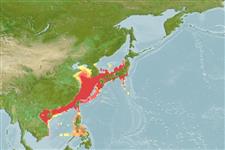Elasmobranchii (tubarões e raias) (sharks and rays) >
Carcharhiniformes (Ground sharks) >
Triakidae (Houndsharks) > Triakinae
Etymology: Mustelus: Latin for weasel, an ancient name for sharks, possibly referring to the pointed snouts, swift movements and/or rapacious feeding behavior of smaller predatory sharks [strictly not tautonymous with Squalus mustelus Linnaeus 1758 since type was designated by the ICZN]. (See ETYFish); griseus: Medieval Latin for gray, referring to gray or gray-brown color. (See ETYFish).
Environment: milieu / climate zone / depth range / distribution range
Ecologia
marinhas demersal; intervalo de profundidade 5 - 300 m (Ref. 104830), usually 51 - ? m (Ref. 104830). Tropical; 41°N - 11°N, 105°E - 142°E
Northwest Pacific: Japan, Korea, China, Taiwan, and Viet Nam (Ref. 244). Possibly occurring in the Philippines (Ref. 13563).
Comprimento de primeira maturação / Tamanho / Peso / Idade
Maturity: Lm 72.0, range 70 - 74 cm
Max length : 87.0 cm TL macho/indeterminado; (Ref. 244); 101.0 cm TL (female); idade máx. registrada: 9 anos (Ref. 6983)
An inshore bottom-dwelling shark found down to at least 51 m (Ref. 244); also dwells in semi-enclosed sea areas with sand bottom (Ref. 11230). Probably feeds on benthic invertebrates, especially crustaceans (Ref. 13563). Viviparous, with a yolk-sac placenta (Ref. 244).
Viviparous with a yolk-sac placenta. Produces 5 to 16 young per litter, with larger adults having larger litters of young. Gestation period is 10 months, birth occurring in April and May. Size at birth about 28 cm (Ref. 244).
Compagno, L.J.V., 1984. FAO Species Catalogue. Vol. 4. Sharks of the world. An annotated and illustrated catalogue of shark species known to date. Part 2 - Carcharhiniformes. FAO Fish. Synop. 125(4/2):251-655. Rome: FAO. (Ref. 244)
Status na Lista Vermelha da UICN (Ref. 130435)
Uso pelos humanos
Pescarias: espécies comerciais
Ferramentas
Relatórios especiais
Baixar XML
Fontes da internet
Estimates based on models
Preferred temperature (Ref.
123201): 11.1 - 23.2, mean 18.5 °C (based on 212 cells).
Índice de diversidade filogenética (Ref.
82804): PD
50 = 0.5000 [Uniqueness, from 0.5 = low to 2.0 = high].
Bayesian length-weight: a=0.00224 (0.00105 - 0.00478), b=3.14 (2.97 - 3.31), in cm total length, based on LWR estimates for this Genus-body shape (Ref.
93245).
Nível Trófico (Ref.
69278): 3.5 ±0.4 se; based on diet studies.
Generation time: 5.5 ( na - na) years. Estimated as median ln(3)/K based on 1
growth studies.
Resiliência (Ref.
120179): Muito baixo(a), tempo mínimo de duplicação da população maior que 14 anos (tm=5.3-6.5; tmax=9; Fec=5).
Fishing Vulnerability (Ref.
59153): High vulnerability (59 of 100).
Nutrients (Ref.
124155): Calcium = 28.8 [8.9, 143.9] mg/100g; Iron = 0.482 [0.142, 1.730] mg/100g; Protein = 20.7 [18.3, 23.0] %; Omega3 = 0.0918 [, ] g/100g; Selenium = 85.5 [25.8, 320.1] μg/100g; VitaminA = 15.1 [5.3, 42.3] μg/100g; Zinc = 1.07 [0.47, 2.18] mg/100g (wet weight);
